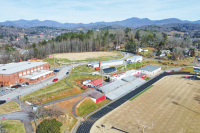What is freestyle kayaking?
 Combining an array of difficult tricks, precision paddling and finely tuned choreography, freestyle kayaking can be described as aquatic gymnastics.
Combining an array of difficult tricks, precision paddling and finely tuned choreography, freestyle kayaking can be described as aquatic gymnastics.
With fast-moving rivers taking center stage, paddlers attack the rapids (or “hole”) with a set routine. Alongside help from The Wave — a manmade underwater concrete structure that creates a near-perfect wave each time — athletes will go one by one into the Nantahala River and perform to the best of their abilities.
The kayaks used for freestyle aren’t your typical water devices. They are smaller, more maneuverable kayaks compared to typical whitewater brands. Freestyle involves sleeker and lighter carbon-made kayaks, each weighing in around 15 pounds unlike traditional plastic models coming in at 30 pounds or more. The end result with freestyle model kayaks is more of a range of motion for paddlers to execute combinations of tricks to perfection.
Once in the water, paddlers find themselves in The Wave, which re-circulates rushing water causing a flow back upstream creating a continuously rolling wave. During their routine, competitors perform their tricks that can have them doing spins, cartwheels, 360-degree rotations and everything in between. Between the water and the athlete, the possibilities are endless, with each technique and trick as unique as the paddler themselves.
When competitions are underway, paddlers each get 45 seconds per run to perform their routine. They try to fit in as many tricks in that timeframe, all the while keeping the set crisp and seamless. For every trick and movement, paddlers are awarded points. The harder the trick or bigger the air gained, the more points scored from the five-judge panel.
Categories for the championships include kayak (K-1), closed deck canoe (C-1) and open canoe (OC-1). Each category has a men’s, women’s, junior men’s and junior women’s division.





